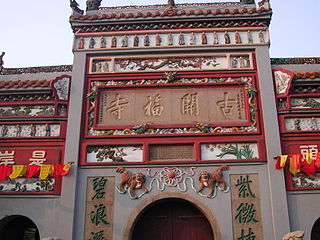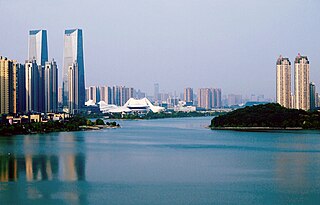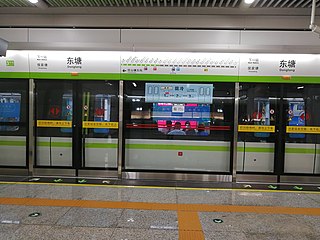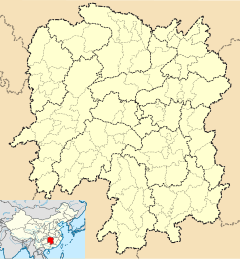
Changsha is the capital and the largest city of Hunan Province in the south central part of the People's Republic of China, located in the lower reaches of Xiang River in northeastern Hunan. Changsha is also called Xingcheng and was once named Tanzhou (潭州) in ancient times. It is also known as Shanshuizhoucheng (山水洲城), for the city, with the Xiang River flowing through it, contains Mount Yuelu and Orange Isle geographically. Changsha, with a total population up to 10 million as of 2020, is the core city of Chang-Zhu-Tan City Cluster and a supercity in China, one of the core cities in Central China, a National Comprehensive Transportation Hub, and one of the first National Famous Historical and Cultural Cities in China. Changshanese, a kind of Xiang Chinese, is spoken in the downtown, while Ningxiangnese and Liuyangnese are also spoken in the counties and cities under its jurisdiction.

Changsha County is a county in Hunan Province, China. It is under the administration of the prefecture-level city of Changsha. Located in the west portion of Changsha, the county is bordered to the north by Miluo City and Pingjiang County, to the west by Wangcheng, Kaifu and Furong Districts, to the southwest by Yuhua District, and to the southeast and the east by Liuyang City. Changsha County covers 1,756 km2 (678 sq mi). As of 2015 it has a registered population of 743,000 and a permanent resident population of 916,000. The county has 5 subdistricts and 13 towns under its jurisdiction. The county seat is Xingsha Subdistrict (星沙街道).

Yuelu District is one of six urban districts of the prefecture-level city of Changsha, the capital of Hunan Province, China. It is the 4th most populous district in Hunan. The district is bordered to the north by Wangcheng District, to the west by Ningxiang County, to the south by Yuhu District of Xiangtan City, across the Xiang river to the west by Tianxin, Furong and Kaifu Districts. Located on the west bank of the Xiang River, as the western part of the City proper, the district is named after Mount Yuelu, one of the national parks, Yuelu District covers 538.83 km2 (208.04 sq mi) with registered population of 644,834 and resident population of 818,900. The district has 16 subdistricts and 2 towns under its jurisdiction, its administrative centre is at Wangyue (望岳街道).

Wangcheng District is one of six urban districts of the prefecture-level city of Changsha, the capital of Hunan Province, China. It is the largest district of Changsha by area. The district is bordered to the north by Miluo City and Xiangyin County of Yueyang, to the west by Heshan District of Yiyang and Ningxiang County, to the south by Yuelu and Kaifu Districts, to the east by Changsha County. Located in the northsouth of the City proper in Changsha, Wangcheng covers 951.06 km2 (367.21 sq mi) with registered population of 560,567 and resident population of 562,100. The district has 10 subdistricts and 5 towns under its jurisdiction, its administrative centre is at Gaotangling Subdistrict.

Furong District is one of six urban districts of the prefecture-level city of Changsha, Hunan Province, China. It is the smallest district of Changsha by area. Furong District is a part of the core of the Changsha urban area, located in the midst of the city. The district is bordered by Yuhua District to the south, Changsha County to the east, Kaifu District to the northwest, and Tianxin District to the southwest. Furong covers 42.68 km2 (16.48 sq mi) with population of 539,200, registered population of 403,948. The district has 13 subdistricts under its jurisdiction, the government seat is at Dongtundu subdistrict.

Kaifu District is one of six urban districts of the prefecture-level city of Changsha, the capital of Hunan Province, China. The district is bordered by Furong and Tianxin Districts to the south, Changsha County to the east and northeast, Wangcheng District to the north, Yuelu and Wangcheng Districts across the Xiang river to the west. Located in the central Changsha, Kaifu covers 188.73 km2 (72.87 sq mi) with population of 595,000, registered population of 452,168. The district has 16 subdistricts under its jurisdiction, the government seat is at Furongbeilu subdistrict.

Changsha South railway station is a metro station and a railway station of Wuguang Passenger Railway and Hukun Passenger Railway. The station is located in Yuhua District, Changsha, Hunan, China. It is a hub and the connecting point of Beijing–Guangzhou–Shenzhen–Hong Kong High-Speed Railway, Shanghai–Kunming High-Speed Railway and the proposed Xiamen-Changsha-Chongqing High-Speed Railway. The station, located in Lituo Street, Yuhua District, was opened Dec 26, 2009. The designer of the station building is from the 3rd department of Central South Architectural Design Institute, INC. The roof features the waves and ripples of water. It has a total construction area of 273,000 square meters and the depot area is 137,000 square meters. It is a transportation center of high-speed railroads, metro lines 2&4, buses, maglev and coaches, which seamlessly connect downtown, Huanghua International Airport and nearby cities.

Huangxing Town is a town in Changsha County, Hunan province, China. It contains two communities and 11 villages. Ganshan township merged with Huangxing on November 19, 2015.

Kaifu Temple is a Buddhist temple located in Kaifu District of Changsha City, Hunan province in the People's Republic of China. It includes Entrance, Hall of the Great Heroes, Assisted dnyana, Dining Room, etc. Kaifu Temple belongs to the Yangqi sect and Linji school of Buddhism. The temple is built within a 16,000 square metres (170,000 sq ft) area of land. For the reason that it was first built earlier than Changsha city, so there is a saying that "there comes first the Kaifu Temple, then the Changsha city".

Xieleqiao Town is an urban town in Ningxiang County, Changsha City, Hunan Province, China. It is surrounded by Huitang Town and Fengmuqiao Township on the west, Shuangfupu Town on the north, Zifu on the east, and Jinsou Township on the south. As of the 2000 census it had a population of 30,370 and an area of 76.5 square kilometres (29.5 sq mi). Fengmuqiao township and Xieleqiao town merged to Huitang town on November 19, 2015.

Guangda station is a subway station in Changsha County, Changsha, Hunan, China, operated by the Changsha subway operator Changsha Metro.

Hunan Martyr's Park is an urban park and the largest park in Changsha, Hunan, China. Covering an area of 343.3-acre (138.9 ha), the park was constructed and opened to the public in 1953. It is a renowned scenic spot integrating memory, leisure and tourism. Hunan Martyr's Park has been designated as a "Provincial Key Cultural Protection Unit" by the Hunan government and a "National Patriotic Education Base" by the Publicity Department of the Communist Party of China. In 2009 it was categorized as a "National Key Park" by the Ministry of Housing and Urban-Rural Development.

Changsha Mosque is a mosque located on Mount Huilong (回龙山) in Tianxin District of Changsha, Hunan, China. Changsha Mosque is the site of Changsha Islamic Association.

The Changsha Bamboo Slips Museum is a history museum located at No. 92 of Baisha Road in Tianxin District, Changsha, Hunan, China. It is adjacent to Baisha Well in the south and Tianxin Pavilion in the west. Changsha Jiandu Museum is currently a large-scale modern themed museum dedicated to the collection, preservation, arrangement, study and exhibition of bamboo script (Jiandu). It is also an important spot of cultural and scenic interest and a window to showcase Changsha to the world. It covers an area of 14,100-square-metre (152,000 sq ft).

Beichen Delta station is a subway station in Kaifu District, Changsha, Hunan, China, operated by the Changsha subway operator Changsha Metro. It entered revenue service on June 28, 2016.

The Changsha Museum is a history museum located at Beichen Delta in Kaifu District, Changsha, Hunan, China. It is adjacent to the Changsha Concert Hall, Changsha Planning Exhibition Hall and Changsha Library. It has a constructed area of 24,000-square-metre (260,000 sq ft).

The Changsha Library is a public library located at Beichen Delta, in Kaifu District, Changsha, Hunan. Changsha Library has a collection of over 1 million items, with 31 thousand newspapers, 42 thousand audiovisual literatures, 8,900 ancient books, and 13 thousand local documents.

The Li Zijian Art Museum is an art museum located in Yuelu District of Changsha, Hunan, China. It is adjacent to Yanghu Wetland Park and Xiangjiang New Area Planning Exhibition Hall. Li Zijian Art Museum is the largest private art museum in Hunan. It covers an area of 120,000-square-metre (1,300,000 sq ft) and a building area of 25,000-square-metre (270,000 sq ft), comprises the Li Zijian Oil Painting Exhibition Hall (李自健油画展厅), Chen Xichuan Sketch Exhibition Hall (陈西川素描展厅), Venerable Master Hsing Yun One-stroke Calligraphy Exhibition Hall (星云大师一笔字书法展厅), and Water Music Hall.

Meixihu Subdistrict is a subdistrict of Yuelu District in Changsha, Hunan, China. It was formed from a part of Tianding Township in April 2007. The subdistrict has an area of 20.2 square kilometres (7.8 sq mi) with more than households of 29,359 and a permanent residential population of about 20,000. As of 2017, the subdistrict has two villages and six communities under its jurisdiction. Its seat is Jiashun Community (嘉顺社区). The subdistrict is the home and the core zone of Xiangjiang New Area.

Dongtang station is a subway station in Tianxin District, Changsha, Hunan, China, operated by the Changsha subway operator Changsha Metro. It entered revenue service on 28 June 2020.















